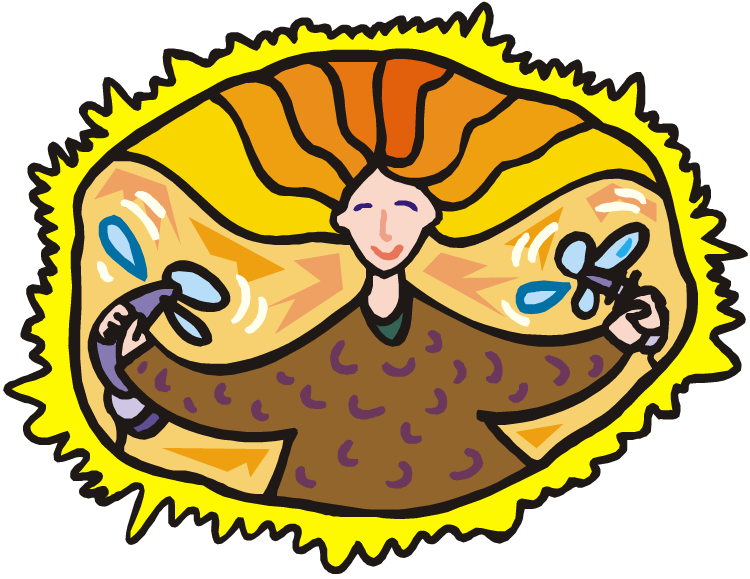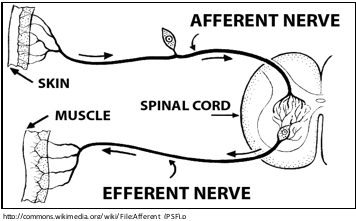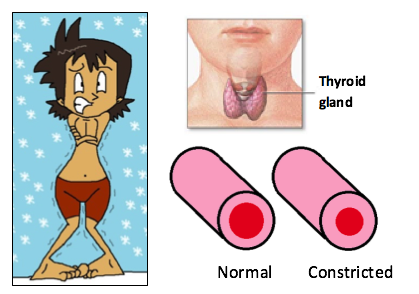Thermal Station 3.2 Lab
Thermal Systems in Health Fields
How the Body Regulates its Temperature Sensation
Materials Required:
- Carolina “Cutaneous Sensations Kit”
- Thermometer
- Hot plate
- Ice bucket filled with ice
- Beaker of warm water
- Beaker cold water
- Paper towels
- Pencil
- Calculator
- Answer sheet
Objectives for Experiment:
- Identify the structures in the body that sense warm and cold temperatures
- Describe how the body transmits sensory information to the brain
- Define a negative feedback loop and explain how this is used to monitor thermoregulation
- Map out the distribution of each type of thermoreceptor for three locations on the hand and arm
- Correctly define the terms in bold from the introduction
- Correctly answer application questions relating to the lab experiment
Prerequisite Knowledge:
- Minimum 6th grade reading level. All instructions are provided.
- Completion of Station 3.1
Process Summary: At this station you will…
- Review the medical vocabulary and read instructions on how to perform an experiment related to temperature sensation.
- Map out cold thermoreceptor sites for three locations on the hand and arm
- Calculate cold receptor density
- Map out warm thermoreceptor sites for the same three locations on the hand and arm
- Calculate warm receptor density
- Use critical thinking skills to provide possible explanations for differences in receptor density and temperature sensitivity
Applied Health Terminology: Like many professions, the medical field has its own vocabulary. We have created flashcards to help to help you learn some of the vocabulary related to temperature regulation in the human body. You can find these flashcards on the computer at the site below.
Instructions to site:
- Click on the link below.
https://quizlet.com/90316148/thermal-station-32-temperature-sensation-flash-cards/
- Then click on the “Flashcards” button in the upper left corner of the screen.
- For each card, say the word out loud or in your mind and try to say what you think the definition is.
- Flip the card by clicking on it and say the definition listed out loud or in your mind.
Evaluation: Your lab performance will be evaluated by the criteria (standards) you will find in this project’s rubric. A rubric is simply a table that states how you will be evaluated. Your coach will use this table to report your performance.
CLICK HERE TO GO TO THE RUBRIC
* We suggest that you complete Station 3.1 which covers thermoregulation before starting this station.
INTRODUCTION
At station 3.1, you learned that humans are endotherms, meaning that we are able to maintain a constant core temperature using thermoregulation.
| You also learned that normal body temperature for humans ranges from 97.5 to 100° Fahrenheit (°F), with the ideal being about 98.6° F (or 37° Celsius, written as °C). You also learned that the hypothalamus is constantly working to maintain this ideal set point.Keeping our body temperature near the set point is an important part of homeostasis, which, as you may remember, is when all of the systems in the body are in a balanced state to maintain overall health. | 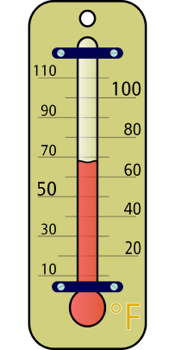 |
Finally, you learned about several mechanisms that the human body uses to either prevent or increase heat loss.
But how does the body determine whether it’s hot or cold? How does the brain know when to activate these mechanisms, and then when to shut them off again? The answer lies within the somatosensory (so-MAA-toe-SEN-sore-ee) system.
The Somatosensory System
This complex system includes all of the senses that are spread out over the entire body rather than contained in one body part (basically everything other than sight, hearing, taste, smell, and balance). You may be thinking, well isn’t that pretty much everything? What else is there besides our sense of touch? Actually we have a lot more senses than you might think!
| Some of the senses in the somatosensory system include pain, tickle, itch, sensation of movement, awareness of body position (like if you’re upside down, right-side up, or on your side), and of course your sense of touch through the skin. But the skin is also able to sense pressure, vibration, and yes, temperature! These three senses along with the sense of touch are called the cutaneous (cue-TANE-ee-us) senses (cutaneous simply means “skin”). |
|
All cutaneous sensations begin by activating certain receptors in the skin. Receptors are groups of specialized cells that respond to a specific stimulus (an event that causes the receptor to become activated). Once they receive the correct stimulus, these cells create an electrical signal called an action potential (AK-shun puh-TEN-chul), which is transported to the brain through long electrical fibers called nerves. Every nerve in the body is made up of millions of individual cells called neurons (NUR-ons).
The biggest collection of neurons outside the brain is the spinal cord, which transfers all information between the body and the brain. The brain and spinal cord together make up the central nervous system, which is often just called the “CNS”. All other nerves throughout the body make up the peripheral (per-IF-er-uhl) nervous system, or the “PNS.” |
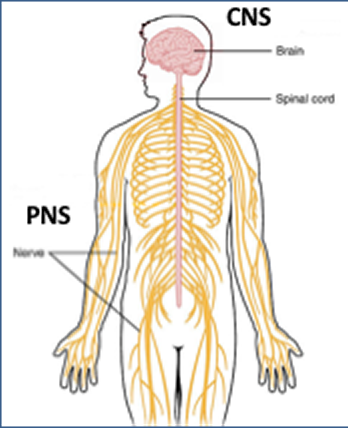 |
If you happen to have already completed lab 4.1, you may remember that there are three main types of neurons, and each type can group together to form nerves:
- Efferent (EFF-ur-ent) neurons transmit messages from the brain to the body in order to tell parts of the body to move or perform certain functions. These are also often called motor neurons. Efferent neurons always transport signals from the central nervous system to the body. Many of these neurons together make up efferent nerves.
- Afferent (AFF-ur-ent) neurons transmit all information having to do with the senses from the body to the brain, which is why they are also called sensory neurons. Afferent neurons always transport signals from the body to the central nervous system. Many of these neurons together make up afferent nerves.
- Interneurons are the third neuron category. These simply form connections between other neurons. This is actually the most common type in your body.
It can be very difficult to remember which one is which, right? “Afferent” and “efferent” look so similar! But here is a memory tool that may help you to remember the difference:
- Cold receptors are only activated when they are exposed to decreases in temperature between 50 and 110 °F (from 10 to 43 °C), with the greatest sensitivity around 77 °F (25 °C)
- Warm receptors are only activated when they are exposed to increases in temperature between 86 and 122 °F (from 30 to 50 °C), with the greatest sensitivity around 113 °F (45°C)
- Stimulus (in this case, a change in temperature)
- Sensor (the thermoreceptors)
- Control center (the hypothalamus)
- Effectors (the body parts that change to either prevent or speed up heat loss)
- The muscles, which start shivering
- The thyroid, which releases hormones to increase the body’s metabolism
- And the blood vessels, which constrict and move away from the skin surface.
afferent neurons approach the CNS
and efferent neurons exit the CNS
Thermoreceptors
Receptors that respond specifically to temperature are called thermoreceptors (THERM-oh-res-EPT-urs). These receptors are very sensitive to changes in temperature. In fact, they are able to sense changes as small as two-hundredths (0.02) of 1°F!
Thermoreceptors are divided into two main categories based on where they are in the body: central and peripheral (per-IF-ur-uhl). Central thermoreceptors are located within the CNS (the brain and spinal cord), and allow the hypothalamus to monitor the body’s core temperature.
| Peripheral thermoreceptors are located throughout the skin, and their structure is referred to as what are called “free nerve endings.” This means that rather than ending in a “ball” of nerve fibers under the surface of the skin, they end in a small branching network of fibers that almost look like a tree. | 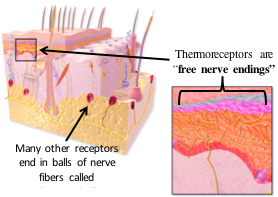 Modified from https://commons.wikimedia.org/wiki/File:Blausen_0803_Skin _Free NerveEndings.png |
Peripheral thermoreceptors are the main focus of this lab station. We will simply call them “thermoreceptors” from this point on.
Something interesting about thermoreceptors is that any one receptor is only able to respond to warm or cold, but not both. Also, warm and cold receptors are only located at specific points in the skin, rather than throughout the entire skin surface. This means that there are certain areas that can respond to cold but not warm, other areas that can respond to warm but not cold, and even places where you cannot sense temperature changes at all!
It is also important to note that warm and cold receptors are only triggered within certain temperature ranges:
AND
You may now be thinking, that doesn’t make any sense! If that’s true, how do I know when somethings really hot or cold? I’d be able to touch a stove or stick my hand in a bucket of ice and never know it!
| And you’re right! But hold on, when you touch a hot stove or stick your hand in a bucket of ice, what do you really feel? Rather than saying you feel hot or cold, wouldn’t you say you actually feel pain instead? That’s because when our skin is exposed to temperatures of less than 50 °F or more than 122 °F, a special type of thermoreceptors called thermal nociceptors (NO-sih-SEPT-urs) are activated. These are basically “temperature pain” receptors which only respond to temperatures that the body recognizes as extremely dangerous. |  |
This function is very important to your safety, because if you felt something really hot or cold, but didn’t necessarily feel pain, you may not pull away immediately! Then the tissue would definitely get burned or damaged.
Normal Skin Temperature
Normal skin temperature ranges from about 86 to 96.8°F (30 to 36°C). This is much lower than the body’s core temperature (around 98.6°F or 37°C), because the skin is constantly losing heat to the environment. Interestingly, this means that the skin’s temperature often falls within the active range for both cold and warm receptors! So are both types triggered at the same time? The answer is yes!
When your skin is in the range of normal temperatures, both types of receptors are active at the same time! But, we do not usually get a sensation of cold or warm. This is called the neutral thermal region.
Sensitivity
Each thermoreceptor is only able to pick up sensations from a specific area of skin surrounding it. The area where a single receptor is sensitive to either cold or warm temperatures is called its receptive (ruh-SEPT-iv) field. A single receptive field is tiny: only a few millimeters across. That’s only about the thickness of two pennies stacked on top of each other! |
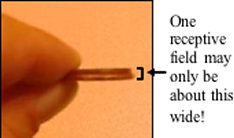 |
But, we are usually unaware of the fact that only small sections of our skin are able to sense changing temperatures. How often do you touch something that small? Most things we touch are big enough that the receptive field of at least 1 thermoreceptor is activated (and more often than not, dozens are probably activated at once).
Plus, the number of warm or cold receptors in different areas of the body tends to differ greatly, making some areas more sensitive to temperature changes than others. The number of thermoreceptors in a specific area, usually measured in square millimeters (mm2), is called the receptor density. A greater density of either warm or cold thermoreceptors means that a particular area will be more sensitive to those temperature changes.
When a receptor is triggered, it fires an action potential that is transported to the central nervous system through afferent (sensory) nerves. Once the message reaches the brain, the hypothalamus processes the information and decides whether or not any changes need to be made to keep the body’s overall temperature near the set point.
As you saw earlier, thermoreceptors in the skin are constantly firing even when your skin temperature is normal. If your temperature is close enough to the set point, the hypothalamus will not activate any changes in the body. But, if a large enough change in temperature is detected, the hypothalamus will activate one of the thermoregulatory mechanisms discussed in station 3.1. |
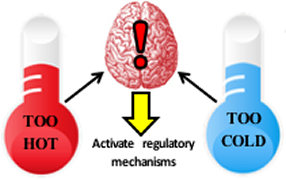 |
But what keeps these mechanisms from staying on? How does the hypothalamus know when it’s time to turn the mechanisms back off?
The answer is something called negative feedback. The easiest way to explain negative feedback is as a process where a change is triggered in the body and the outcome of that change acts as a signal to turn the process back off again.
This might be a little confusing so let’s break it down into steps. Negative feedback occurs in a loop that has four parts:
Look at this diagram which shows an example of the body getting too hot and sweating as a result. Follow the numbered steps to see how this negative feedback loop works…
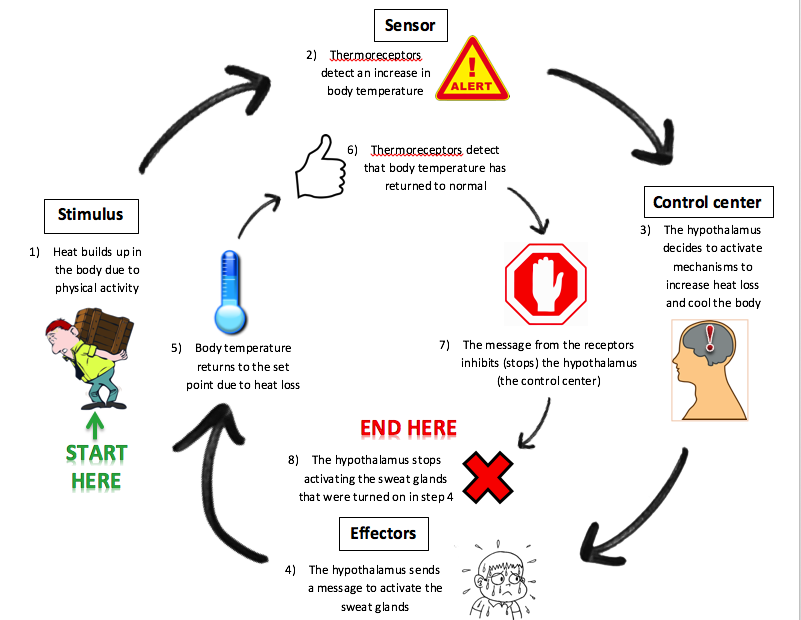
Every time the body’s temperature gets too hot or cold, the hypothalamus will activate one or more of the thermoregulatory mechanisms discussed in station lab 3.1. Each mechanism uses its own feedback loop like the one shown above!
For example, while the body begins the process for sweating (shown in the diagram), the hypothalamus also triggers the blood vessels to dilate, or get wider in order to let heat escape through the skin. In this loop, the blood vessels would be the effectors.
On the other hand, if the body becomes too cold, several other feedback loops are activated. In all of these loops, the sensors (thermoreceptors) and the control center (hypothalamus) remain the same. The only differences are that the stimulus is now a drop in temperature, and the hypothalamus activates the following effectors:
|
In all three of these loops the body’s return to a normal temperature acts as negative feedback to the hypothalamus, which can then turn all of these processes back off.
Negative feedback loops are actually very common in most of the body’s organ systems because they are so effective at keeping a certain factor within the range for homeostasis (meaning at or around its set point). In fact, your blood pressure, the release of dozens of hormones, and even the level of oxygen in your blood are all controlled through negative feedback loops!
There is also a mechanism called positive feedback. In this case, the outcome of a change actually enhances the process and keeps it going. However, this is much less common in the body, because it actually pushes the body away from homeostasis. (But you don’t need to worry about positive feedback right now, just focus on understanding negative feedback.)
For a summary of negative feedback loops in detail, click on the link below and complete the animation. When you’re done, click on the “Links” button in the bottom right corner and click on “Negative Feedback Loop – Concepts and Connections” to do an activity and test your understanding! |
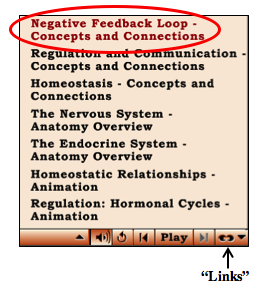 |
__________________________________________
Links to Station 3.2 Modules
Lab Intro | Lab Presentation and Practice | Communications Intro| Communications Presentation and Practice| Math
